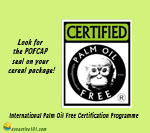Are you a label reader? You pretty much have to be, these days, in the interest of both your health and the environment.
There are lots of ingredients to watch out for, and palm oil is one of the most prevalent. But if you shop around, you can usually find an alternative.

What makes palm oil so bad? We used to think its high saturated fat content made it bad for the heart, but recent studies suggest no correlation between saturated fats and heart health.
The concern about palm oil today is on the environmental and climate change fronts.
On the environmental front, for starters, palm oil is a water pollutant. According to the World Wildlife Fund, “A palm oil mill generates 2.5 metric tons of effluent for every metric ton of palm oil it produces. Direct release of this effluent can cause freshwater pollution, which affects downstream biodiversity and people.”
The next problem not only affects the environment, it also contributes to the climate crisis. Once a palm tree grows tall enough that the fruit becomes difficult to reach, the tree is cut down and a new tree is planted in its place. This contributes to deforestation of the rainforest and loss of animal habitat.
The Food and Agriculture Organization’s 2016 State of the Forests report revealed that we are losing 7 million hectares of forest every year. And, as we all know, deforestation is a major cause of the increasing CO2 in Earth’s atmosphere. While palm oil isn’t the only culprit, it plays a significant role.
And then there’s palm oil’s contribution to the issue of loss of peatland, which contributes to environmental degradation. Many Indonesian and Malaysian rainforests, from which 84% of the world’s palm oil is derived, lie atop peat bogs that store great quantities of carbon.
Forest removal and bog drainage to make way for plantations release this carbon, which is responsible for four percent of global greenhouse gas emissions and eight percent of all global emissions caused annually by burning fossil fuels.
And now we circle back to the beginning of this article, and label reading. According to the International Palm Oil Certification Programme, these are the palm oil ingredients we should be watching for:
- Glycerin
- Anything with the word Tocopherols
- Mixed Tocopherols
- Tocopherol / Vitamin E
- Tocopherols to Maintain Freshness
- Palm Oil and Palm Kernel Oil.
Glycerin, which can be derived from a number of vegetable oils, is a major constituent of packaged foods, cosmetics and pharmaceuticals. Trouble is, one of those sources is palm oil. If the label doesn’t specify otherwise, you have to suspect that may be its source.
And the same for tocopherols, a class of fat-soluble compounds with vitamin E activity, best known for its antioxidant activity. While tocopherols are found in a variety of vegetable oils, including olive oil, soybean oil and wheat germ oil, they are much more abundant (hence less expensive to extract) in palm oil.
Label reading is tricky. And now that the public is aware of the downside of palm oil, packagers are finding ways to list it on labels without mentioning the oil itself. So … beware.
As the World Wildlife Fund states, “You might not cook with it, but you almost certainly eat or use palm oil. Palm oil is the most widely consumed vegetable oil on the planet, found in many packaged products sold in the supermarket.”
At the same time, WWF encourages us not to boycott palm oil, as “boycotts will neither protect nor restore the rainforest, whereas companies undertaking actions for a more sustainable palm oil industry are contributing to a long-lasting and transparent solution.”
Indeed, WWF has undertaken to certify palm oil manufacturers that have committed to making the industry more sustainable.
So, before you next shop for groceries, check out their Palm Oil Buyers’ Scorecard!
And to stay on top of issues that affect our lifestyle’s sustainability, consider joining Team GreenSaver—families and individuals working together to learn and take meaningful action on sustainability issues from climate change to nuclear waste safety and beyond.
To your eco-active empowerment,
Chiwah
Eco Activist 🙂 Kids’ Book Author 💡 Editor 😯 Book Formatter 😎 Cover Designer 😀 Publisher
AWriteToKnow.com, PetWrites.com
Email: Info@EcoActive101.com

